This afternoon, I finally made it to one of my dream Parisian restaurants for the first spot of fine-dining of this French sojourn. Pavillon Ledoyen, situated at the eastern end of the world-famous Champs-Élysées on a large green space and overlooking the Petit Palais, has been a temple of gastronomy for more than two centuries with a fascinating history and an illustrious track record. It was established as a formal restaurant in 1792 and transferred to its present location in 1842. Pavillon Ledoyen was a favourite amongst major French artists and writers of the 19th century, and most famously also the regular meeting place of Napoleon and his wife Joséphine. The building is currently owned by the City of Paris although the restaurant is in private hands. Ledoyen has maintained 3 Michelin stars since 2002, first under Christian Le Squer (who has now taken over the reins at Le Cinq) and now Yannick Alléno, former head chef at Le Meurice, who returned to Paris in July 2014 to head Ledoyen after a brief absence from Paris.
I arrived in perfect weather and my excitement was palpable as I approached the imposing Neoclassical building with large glass windows.
I was first greeted by the doorman on the red carpet, then by a warm and smiling receptionist, who quickly ushered me up to the main dining room on the first floor. I caught a glimpse of the truly impressive space on the ground floor, and made a mental note to explore it after lunch.
The architecture and interior are as formal as I would expect from a historical building and triple-starred restaurant, but the atmosphere is considerably softened by the use of pastel-coloured panelling and the abundance of natural light due to the glass windows that surround the building. The tasteful décor, with carefully-placed contemporary artwork and bouquets of seasonal flowers, also adds a touch of sophistication.
As requested, I had a table by the window with a lovely view of the dining room and its surrounding greenery. The elegantly appointed room which seats 45 was bright, airy and spacious, bathed in natural light, with a high ceiling and pastel colours throughout, including the restaurant's signature light green upholstery. Being one of the first customers to arrive for lunch, I had nearly the whole space to myself for quite a while, and it was as relaxed and cosy as one could get in a top-class restaurant. The tables are well spaced apart for privacy, and the service is attentive and efficient, but not intrusive.
I chose the four-course lunch menu at 135€, with a substitution for my main course as I wasn't too keen on the Bresse chicken that was offered. As you will see, that substitution turned out to be my favourite dish of today's lunch.
First, a line-up of canapés served on a hard green bread base (only for decorative purposes): from right to left, yellow beetroot ravioli filled with carrot purée, sitting in a small pool of concentrated sorrel juice and garnished with cumin seeds; hibiscus tuile filled with a mousse of Cévennes onions and garnished with wood sorrel; and beetroot brioche stuffed with wild black rice, shallots and parsley, accompanied by a sauce of seaweed, garlic and ponzu. (I am describing them in the order in which I was recommended to eat them.)
First, a line-up of canapés served on a hard green bread base (only for decorative purposes): from right to left, yellow beetroot ravioli filled with carrot purée, sitting in a small pool of concentrated sorrel juice and garnished with cumin seeds; hibiscus tuile filled with a mousse of Cévennes onions and garnished with wood sorrel; and beetroot brioche stuffed with wild black rice, shallots and parsley, accompanied by a sauce of seaweed, garlic and ponzu. (I am describing them in the order in which I was recommended to eat them.)
Already from the beginning there were some truly striking flavour combinations, partly due to the increasing awareness in recent years of the possibilities of exotic Asian spices and condiments in French gastronomy. A delicate acidity ran through all three canapés, which both stimulated the appetite and maintained an apt lightness, in anticipation of the real feast ahead. The ravioli was easily likeable; both beetroot and carrot derivatives had a pleasant earthy sweetness that was perfectly accentuated by the warm, nutty and peppery taste of cumin, and balanced surprisingly but effectively by a crisp tart aftertaste from the sorrel juice. A similar sweet-sour equilibrium played out in the next morsel, with the cranberry-like astringency of hibiscus and tart wood sorrel garnish contrasting nicely with a mousse made from sweet and mildly aromatic Cévennes onions (the only onion cultivar in France with an AOC award). Furthermore, the contrast in textures between the extremely fragile and crispy tuile and the rich and smooth mousse was quite delightful indeed. Finally, the most savoury and substantial of the canapés featured a crisp and airy brioche, infused with the deep earthiness of red beetroot, and filled with a warm, satisfying and fragrant combination of rice and herbs. Its Japanese-inspired accompanying sauce, a concentrated seaweed concoction with a smooth jam-like consistency, was an easy match for the existing flavours and aromas of the brioche. However, like the jewel in the crown, the ponzu base was the truly inspired touch, with its sharp taste discreetly and effectively elevating the overall umami of the sauce, whilst keeping the palate fresh and invigorated for the following courses. It was amazing how well a French chef had understood the nature of this Japanese condiment and appropriated it in his own cultural context. Alléno is in fact particularly well-known in France for his mastery of sauces, and the seaweed sauce was surely a first hint at that.
Bread followed shortly, and I chose two varieties: black olive with sea salt, and multigrain sourdough.
The breads, still warm to the touch and fragrant, were accompanied by both salted and unsalted butter that were very rich and creamy. The black olive bread was soft, fluffy, and generously studded with juicy pieces of black olives, with a delicate sprinkling of sea salt that intensified their briny taste, while the multigrain sourdough was crisp, airy and nutty, with a very mild acidity from the initial process of fermentation. Really nobody does their bread and butter better than the French - I would have gladly asked for more but I also knew that I had to save my stomach space for the actual courses!
Starter
Fine gelée d'un jambon Ibérique, mousse fermentée de pain de seigle aux éclats d'olives Kalamata
Fine jelly of Iberico ham, fermented mousse of rye bread with Kalamata olives
Following on from the excellent canapés, this dish was one masterpiece of a kickstarter for the meal proper. Extremely delicate textures belied some truly intense and vivid flavours here. First, a clear and light jellied base made from Iberico ham consommé unified the predominantly salty components of this dish effectively, with its concentrated smoky and nutty taste underlying each mouthful. This was topped with actual slices of Iberico ham which were delightfully silky and succulent with just the right amount of fat, and had an even nuttier taste than its jellied derivative. On the side, a smooth, airy and earthy mousse made from the essence of rye complemented the ham's nutty flavour perfectly, while slight fermentation produced a mild acidity that tempered the overall saltiness of this starter aptly. Feather-light wafers of toasted rye bread were also present for a pleasant crispiness to go with each bite. Finally, a sprinkling of Kalamata olives, a meaty purple-black variety harvested from Kalamata in Greece and awarded PDO status within the EU, provided further bursts of flavour with their fresh briny taste accentuated by hints of bitterness. On the whole, this memorable dish packed quite a punch despite its dainty appearance, and the balance of flavours and textures was quite impressive indeed.
Fish
Filets de sole braisés en nage printanière, volée de cerfeuil
Fillets of sole braised in a spring broth, with a fresh chervil garnish
Fish
Filets de sole braisés en nage printanière, volée de cerfeuil
Fillets of sole braised in a spring broth, with a fresh chervil garnish
In stark contrast to the previous starter, this was as delicate and elegant in taste as it was in presentation. The sole was incredibly moist, tender and velvety in texture, and its mild flavour was well matched by its equally light braising sauce based on green tomatoes. This sauce had an almost watery consistency, and yet was anything but bland; its subtle sweetness and crisp taste certainly underscored the freshness of the fish. Alléno as a master of sauces sprang to mind once again. Fresh spring peas within the broth contributed further sweetness as well as a gentle crunch in each mouthful. A truly seasonal touch came in the form of fresh meaty girolles, which imparted a lovely fruity aroma and peppery taste that were surprisingly apt complements to the fish (one would normally expect mushrooms to be rather earthy and intense). We are currently at the peak of girolle season so there couldn't have been a better reason to use these highly-prized mushrooms here. To finish, sprigs of chervil were scattered on top of the fish only prior to serving, hence preserving fully its warm and understated anise-like flavour with a slight bitterness. A close relative of parsley, one can't go wrong pairing chervil with fish, though its usage can be a challenge as chervil quickly loses its flavour under exposure to any sort of heat. No such problem here fortunately. What lay before me was a simple but glorious celebration of produce, showcasing each ingredient at its best, and assembling them in perfect harmony.
Meat
Boeuf wagyu Gunma <Grade 4> ferré au sautoir, pommes de terre de Noirmoutier tapées au lait frit, condiments iodés
Pan-seared Grade 4 wagyu from Gunma Prefecture in Japan, pressed Noirmoutier potatoes with fried milk, iodised condiments
This was the absolute pièce de résistance of today's lunch, and I am so glad that I made the substitution. One can never go wrong with real Japanese beef (as opposed to Australian 'wagyu' which in my opinion doesn't even begin to compare), and here I had two chunks of medium rare heaven, even if they were rather small! The meat was extremely tender and melt-in-the-mouth due to the opulent marbling of authentic wagyu. When my server proudly told me that it would feel more like foie gras than beef, I knew exactly what he meant. I was also informed that Japanese beef had only been authorised for import into France over a year ago, around the time Ledoyen opened its doors under Alléno. He clearly knows what's great! Seared on the surfaces to a browned perfection, all that this wonderfully intense meat needed for seasoning was a light sprinkling of pepper and coarse sea salt. The sauce, a rich beef demi-glace, was of course the most natural complement to the meat.
On the side, no luxury was spared with three small potatoes from Noirmoutier, a village on an island in the Atlantic Ocean, just off the coast of the Loire region in Western France. Noirmoutier is famous for cultivating the most expensive potatoes in the world, known as the 'La Bonnotte' variety. Only 100 tons are produced annually, and the potatoes must be fertilised by seaweed and harvested by hand. Not exactly your daily staple, they are only available in top restaurants in France. As expected, these three lovely morsels had a naturally earthy and salty flavour perfect for the beef, and frying with dashi (a seaweed and bonito stock - one of the two 'iodised condiments', and the mother stock of Japanese cuisine) then lightly pressing them resulted in an even more concentrated umami. Their texture was also simply delightful - lightly browned and crisp on the surface, with soft and fluffy insides. On top of each potato were placed a small cube of fried milk curd, rich and creamy in texture with a mild charred taste, and a dollop of mustard infused with oyster reduction (the other 'iodised condiment'), deep in flavour with a fresh spicy kick, perfect for rejuvenating the palate. Could meat and potatoes get any better than this?
It was around this time that Alléno himself emerged from the kitchen to greet guests, and when it was my turn I certainly didn't miss the opportunity to compliment him on a stellar meal thus far and to have a photo. For a top chef, he was a lot more affable and obliging than I would have imagined.
On the side, no luxury was spared with three small potatoes from Noirmoutier, a village on an island in the Atlantic Ocean, just off the coast of the Loire region in Western France. Noirmoutier is famous for cultivating the most expensive potatoes in the world, known as the 'La Bonnotte' variety. Only 100 tons are produced annually, and the potatoes must be fertilised by seaweed and harvested by hand. Not exactly your daily staple, they are only available in top restaurants in France. As expected, these three lovely morsels had a naturally earthy and salty flavour perfect for the beef, and frying with dashi (a seaweed and bonito stock - one of the two 'iodised condiments', and the mother stock of Japanese cuisine) then lightly pressing them resulted in an even more concentrated umami. Their texture was also simply delightful - lightly browned and crisp on the surface, with soft and fluffy insides. On top of each potato were placed a small cube of fried milk curd, rich and creamy in texture with a mild charred taste, and a dollop of mustard infused with oyster reduction (the other 'iodised condiment'), deep in flavour with a fresh spicy kick, perfect for rejuvenating the palate. Could meat and potatoes get any better than this?
It was around this time that Alléno himself emerged from the kitchen to greet guests, and when it was my turn I certainly didn't miss the opportunity to compliment him on a stellar meal thus far and to have a photo. For a top chef, he was a lot more affable and obliging than I would have imagined.
Pre-dessert
(on the tray) cocoa wafers, confit pineapple wrapped in marzipan, and a traditional Mexican (Aztec) drink of cocoa, vanilla and tonka beans with a dash of pepper
(in the bowl) pear and vanilla sorbet with candied lemon verbena and pear cubes marinated in cider vinegar
Savoury courses done, I was now ready to be impressed by Alléno's pastry chefs. First up, a lovely sorbet that served as a palate cleanser, with a very light and smooth texture, and a fresh sweetness from pear remarkably enhanced by the warm aroma of crushed vanilla pods. Balance came in the form of juicy pear cubes that had been marinated in a mildly acidic cider vinegar, as well as crisp candied leaves of lemon verbena that perfumed the sorbet with their characteristic citrusy aroma. All in all, a very refreshing and effective transition from the substantial preceding dish to sweets.
The heavier second part of pre-dessert featured two cocoa-based items, with a cube of pineapple in the middle for balance. I found the drink particularly interesting, due largely to the infusion of tonka beans, which are native to South America and hugely popular in top French restaurants (though strangely enough, they are officially banned in the US due to the presence of potentially toxic compounds). The wonderfully heady and complex aroma of this bean was evident; there were hints of vanilla, sour cherry, almond and cinnamon, with a mild grassy/hay-like aftertaste. Combined with pure cocoa, vanilla pods and pepper, the result was a fresh, bitter and earthy drink with hints of fruits and nuts, and a warm and spicy finish. Definitely not your typical sweetened hot chocolate with milk despite the similar appearances! On the other side of the plate, wafers made from pure cocoa delighted with their light and crisp texture and deep fruity bitterness, while a juicy cube of pineapple wrapped in a thin layer of smooth and chewy marzipan contributed an essential sweetness, and fit the tropical theme of this platter nicely. With such outstanding pre-desserts, I could hardly wait to see and taste what other surprises would follow in the main dessert and petit fours.
Dessert
Meringue soufflée de fraises au sésame noir, chlorophylle de shiso
Black sesame meringue with strawberry compote, crushed shiso leaves and black sesame sorbet
The potent flavour of cocoa in the pre-dessert turned out to be a pertinent link to the main dessert, which again was inspired by Japan and the popularity of black sesame desserts there. Compared to the more common white sesame, black sesame offers significantly more health benefits, and in my opinion also has a stronger aroma and deeper nuttier flavour. Indeed, the intensity of this seed was present in full force, both in the sorbet and the meringue - you'd never have guessed from their dainty textures. The meringue was incredibly crisp and airy, while the sorbet was as light and smooth as expected. Nestled within each meringue was also a compote of strawberries, which had kept their shape surprisingly well, and were very soft and plump in texture, with a concentrated tanginess from the long hours of stewing and reducing. Another Japanese touch came in the form of crushed shiso leaves under the sorbet. In Japan, shiso leaves are normally used whole, as a garnish for raw fish; they are said to have anti-bacterial and anti-inflammatory properties. However, their unique minty flavour is also ideal for certain dishes, and many chefs in the West have also picked up on their suitability for desserts. I really loved the use of shiso here; it was truly a welcome breath of fresh air amidst the powerful nuttiness of black sesame and the vivid sweetness of the compote. There was one final unusual ingredient: a sprinkling of black Iranian lime (also known as 'loomi') powder, produced by boiling limes in salt water and drying them in the sun until the inside flesh turns jet black, then pulverising the flesh. This citrus spice powder had a remarkably sweet taste, and a deep aroma with hints of fermentation, that gave the dessert a pleasantly piquant finish. On the whole, I found this marriage of two very different culinary cultures well balanced and sophisticated, with nice little surprises for the sensitive palate.
Petit fours
Guinness crème brûlée tart, chocolate truffles, green tea
Petit fours
Guinness crème brûlée tart, chocolate truffles, green tea
A fine French meal isn't complete without further confectioneries to round off the main dessert, and today two indulgent items were offered: first, dark chocolate truffles, dusted with cocoa powder and sitting on a bed of cocoa nibs (edible, but mainly for decorative purposes as they are rather hard and bitter). These chocolate truffles were extremely soft, chewy and rich, being made directly from a thick and simple mixture of fresh cream and chocolate that had been heated, then allowed to cool and set in a mould, before being cut into cubes and rolled in cocoa powder. There was no added milk or sugar that might have diluted the chocolate and compromised its flavour. The truffles were best enjoyed fresh, and all I got was pure heady pleasure with each bite. I couldn't get enough of them despite the apparently generous serving!
The second item was a traditional crème brûlée tart, given an Irish twist by the addition of Guinness to the custard mix (hence the darker-than-usual colour of the end product). This turned out very well indeed; the lush and velvety custard was effectively tempered by a bittersweet malty edge from roasted barley, which prevented it from becoming too cloying. The top layer of caramelised sugar was thin and crisp, with an agreeable charred taste that also helped to balance the custard somewhat, while the pastry base was very delicate and had an aromatic buttery crunch. Faultless.
It had truly been one of life's greatest pleasures to dine in such beautiful surroundings, and as I continued sipping my tea, I couldn't help but feel how fortunate I was. Meanwhile, the dining room had filled up but the atmosphere remained very restful, without the slightest hint of hushed stuffiness; everyone was just naturally relaxing and enjoying themselves. When the food and service are this good, one doesn't have to try too hard to feel at home!
I remembered to take a look at the rest of the building, and was shown around briefly by the receptionist who had received me at the beginning. There are quite a number of rooms of varying sizes on the ground floor, which may be booked for private events such as company functions and weddings. How luxurious and expensive that must be!
There's Alléno chilling out with some regulars in the lounge just by the entrance to the building:
Just before I left the building, the lovely receptionist handed me two financiers as a parting gift, which made my day just that little bit sweeter. This meal had been a masterclass in flavours and textures (particularly the sauces which Alléno calls 'the voice of French cuisine'), and was also a manifestation of the best kind of cultural appropriation or 'fusion' in gastronomy, wherein the chef was fully sympathetic to the natures and possibilities of the exotic ingredients that he was using. Alléno has truly distinguished himself by straddling both innovation and tradition with remarkable finesse. I know I will be back someday for the full tasting menu experience!




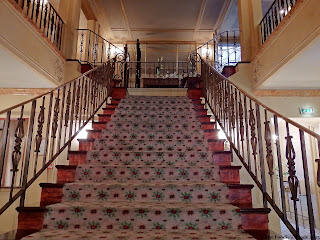
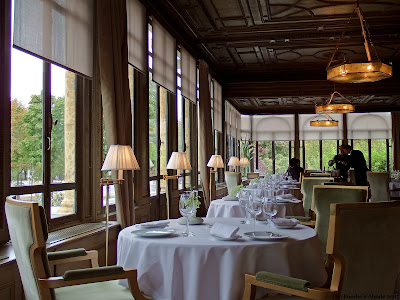






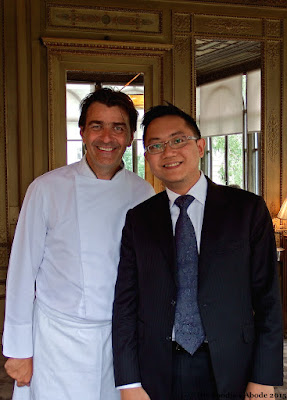





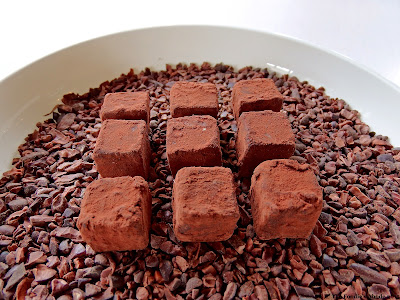

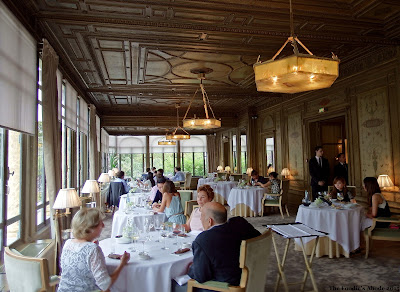



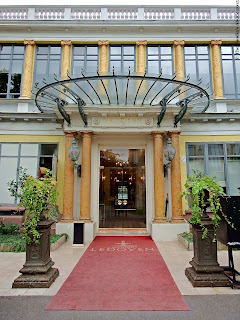
No comments:
Post a Comment